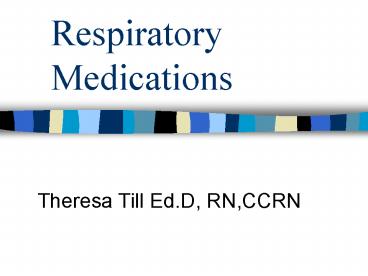Respiratory Medications - PowerPoint PPT Presentation
1 / 28
Title:
Respiratory Medications
Description:
Nicotine Patch Medications that Treat Respiratory Disease Steroids REDUCE INFLAMMATION. CONSIDERED A DRUG OF PREVENTION Not used acutely Best to use spacer ... – PowerPoint PPT presentation
Number of Views:187
Avg rating:3.0/5.0
Title: Respiratory Medications
1
Respiratory Medications
- Theresa Till Ed.D, RN,CCRN
2
(No Transcript)
3
(No Transcript)
4
Pathophysiology of Asthma
- HYPERRESPONSIVENESS OF AIRWAYS that results in
- Usually, reversible constriction of bronchial
smooth muscle (bronchoconstriction). - Hypersecretion of mucus
- Mucosal inflammation and edema (Considered more a
disease of inflammation than obstruction
obstruction occurs secondarily)
5
Triggers to Asthma
6
Asthma(narrowed airways)
7
Asthma
8
Chronic Bronchitis
- Usually caused by smoking or inhaled irritants.
- Mega mucous
- Airway inflammation
- Irreversible
9
EmphysemaAlveolar Destruction
10
Emphysema
- IRREVERSIBLE destruction of alveolar walls which
decreases surface area for gas exchange. - Loss of lung elasticity springs that hold open
alveolar walls are sprung and collapse. - Air becomes trapped and distal airways
hyperinflate and rupture.
11
Quit smoking
- Major cause of COPD.
12
Nicotine Patch
13
Medications that Treat Respiratory Disease
- Steroids
- REDUCE INFLAMMATION.
- CONSIDERED A DRUG OF PREVENTION
- Not used acutely
- Best to use spacer (aerochamber) to decrease
systemic effects. - Rinse spit after use.
- Commonly ends in sone, olone
14
Bronchodilators
- Fast acting USED ACUTELY.
- Open airways. Most bronchodilators are given via
nebulizer, MDI or DPI. - Beta adrenergic agonists (erol, enol) Common side
effects are palpitations , tachycardia. Note If
patients are using more than one canister a month
(200puffs), their disease is in poor control.
Dont use as fire extinguisher. Ask why is
fire breaking out?
15
Bronchodilators
- Bronchodilators (fast or slow acting) work by
relaxing muscle walls and thereby making the air
passage larger.
16
Bronchodilators
- Methylxanthines theophylline Aminophylline
second line drug given when extra treatment is
needed. Given IV or PO. Most common side effects
of aminophylline are tachycardia, shakiness, and
palpitations. - Anticholinergics relax bronchial smooth muscle
but less effective than beta agonists. - http//www.use-inhalers.com/
17
Respiratory PreventativesMast Cell Stabilizers
- Not used acutely. Used to prevent an exacerbation
of asthma. - Examples of mast cell stabilizers
- Cromolyn (Intal)
- Nedocromil (Tilade)
- Inhibit histamine release from mast cells thus
decreasing immune response.
18
Respiratory PreventativesLeukotriene Modifiers
- Not used acutely. Used to prevent an exacerbation
of asthma - Leukotriene Modifiers interfere with synthesis
or block the action of leukotrienes which cause
inflammation. Examples are - lukast
- Montelukast (Singulair)
19
Valuable Miscellaneous Interventions
20
Respiratory and Physical Therapy
- Encourage to attend pulmonary rehabilitation
classes (exercise supervised by professionals) - Breathing retraining (handout)
- Purse-lip
- Diaphragmatic (abdominal breathing)
- Increase exercise tolerance
- Effective coughing
- Flutter mucus clearance device
- Acapella- hand-held device that loosens
secretions via vibrations positive pressure - Teach patients to assess sputum
- Avoid conversation with exercise
21
Metered Dose Inhalers
- Common treatment.
- Note location of MDI when a spacer or aerochamber
is not used.
22
Peak Flow Meters
23
Flutter Mucus Device
24
COPD
- Abdominal Breathing
25
Pursed Lip Breathing
- http//www.bing.com/videos/search?qteachingpurse
dlipbreathinganimationqsnformQBVRpqteachi
ngpursedlipbreathinganimationsc0-30sp-1sk
viewdetailmid76EC2961EE65A64565A976EC2961EE65
A64565A9
26
Nutritional Therapy
- Weight loss and malnutrition are common
- Pressure on diaphragm from a full stomach causes
dyspnea - Difficulty breathing while eating leads to
inadequate consumption - Drink fluids in between meals
- Rest at least 30 minutes prior to eating
- Frequent small meals (high calorie and protein)
- Prepare foods in advance
27
Respiratory Therapy
- Aerosol nebulization therapy
- Deliver suspension of fine particles of liquid
(medication) in a gas - Easy to use
- Must be kept clean at home to prevent bacterial
growth
28
Managing Oxygen Liter Flow
- Outdated information Never exceed 2 liters of
oxygen per nasal cannula for patients with
chronic lung disease because can knock out drive
to breath. This can occur but is rare. - New standard is to use oxygen saturation level
as guide to how much oxygen to deliver. Increase
oxygen level to maintain therapeutic oximetry. If
Sp02? with ? O2, stop.































